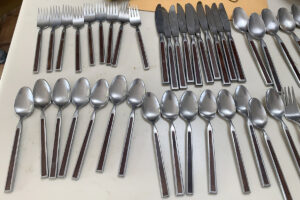 DS owns a set of Stanley Roberts International House of Design stainless flatware accented with inserted rosewood running down the handles. Very modern, and hot today, as American modern stainless and sterling flatware is sleek and simple—desirable in the market. Plenty of 1950s and 1960s wedding sets of both stainless and sterling flatware services exist. Hint: your jeweler will professionally polish the sets, if damaged.
DS owns a set of Stanley Roberts International House of Design stainless flatware accented with inserted rosewood running down the handles. Very modern, and hot today, as American modern stainless and sterling flatware is sleek and simple—desirable in the market. Plenty of 1950s and 1960s wedding sets of both stainless and sterling flatware services exist. Hint: your jeweler will professionally polish the sets, if damaged.
Stanley Roberts International House of Design
Stanley Roberts International House of Design became the largest importer of stainless flatware in the US till the early days of the 1970s. They took advantage of the cheap, exquisitely precise laborers in Japan and Korea. DS’s set is marked with the pattern name “Kamaran” and ‘Stainless Japan.’ The whole set has two market values: worth $1,000 (service for twelve) to the Palm Springs midcentury collector, and $200 to the garage sale collector.
Other fabulous MOD designs by Stanley Roberts include the pattern called “Cycles” with a long wide “O” shape for the handles. The “Maestro” pattern came with an inch-and-a-half thick flat handle with geometric raised designs of embossed diamonds in circles. My mother’s neighbor, Mrs. Martorella in Deerfield Illinois, decorated in the latest modern styles, setting her table with these patterns.
American flatware, both the modern sterling and stainless patterns, show a resurgence in today’s market. First modern patterns in the 1930s came from France and Denmark. US flatware companies didn’t clue up to the modern market till the mid 1950s. Then they seized the optimum opportunity. During WWII the US stockpiled silver for use in electronics, after the war the government sold for reasonable silver prices. US silver flatware companies bought, realizing the eras previous to the mid 1950s considered sterling silver flatware a luxury commodity. Only the wealthy set a table with sterling. After WWII the middle class could afford silver flatware. The media capitalized on this, advertising to brides, encouraged by the dual powerhouses of etiquette, Emily Post and Amy Vanderbilt. Sterling flatware, in a certain pattern, with each bridal guest buying one place setting, became recommended as de rigueur!
Patterns made by great American booming sterling flatware companies in the midcentury got copied in stainless. They did some tweaking to avoid copyright issues. Some of the finest American designers worked for the sterling manufacturers, such as Raymond Loewy.
Some ultra-modern American patterns presented to a couple for a 1950s or 1960s wedding:
- 1948 Towle, “Contour”
- 1954 “Theme”
- 1956 “Celeste”
- 1953 International Silver “Silver Rhythm”
- 1957 Gorham “Stardust,” and Wallace “Discovery”
Stardust appeared like it sounds: a simple handle with star patterns, copied in stainless and on chrome plated utensils you bought at Kresge’s. On that note, the best stainless flatware contains ten percent nickel, making it more durable, resistant to bending—think of an ice cream spoon. Nickel offers protection against corrosion and creates luster and shine. Stainless flatware with no nickel is cheaper and found in fast food restaurants! DS’s stainless is heavy, indicating nickel.
On the other hand, Reed and Barton made the finest, heaviest, and most expensive modern sterling flatware pattern in 1958. It became as popular, as it was pricey, so elegantly simple, that it’s highly collectible. Designed by Danish John Prip and sketched by none other than Gio Ponti. The favorite and distinctive “Vision” of 1961 was, and still is, the most unique. The handle is canted to the side instead of laying flat on a table. Thus the fork or spoon bowl is at right angles to the handle!
Valuable Flatware Hints:
People should use their sterling every day, just like pearls should be worn often. If you put stainless and sterling flatware together in those baskets used in a dishwasher, the sterling comes out spotted. DS’s stainless pattern named “Kamaran” has a wood insert and shouldn’t be soaked. Dishwasher detergent leaves a white haze on all flatware. On sterling it’s almost impossible to polish away. Detergents that contain lemon or citrus additives aren’t good for sterling. Neither is “saran” wrap, although as an appraiser I see drawers of sterling wrapped like that. Over time the wrap and sterling will fuse. Drying immediately after washing by hand is always the best practice.